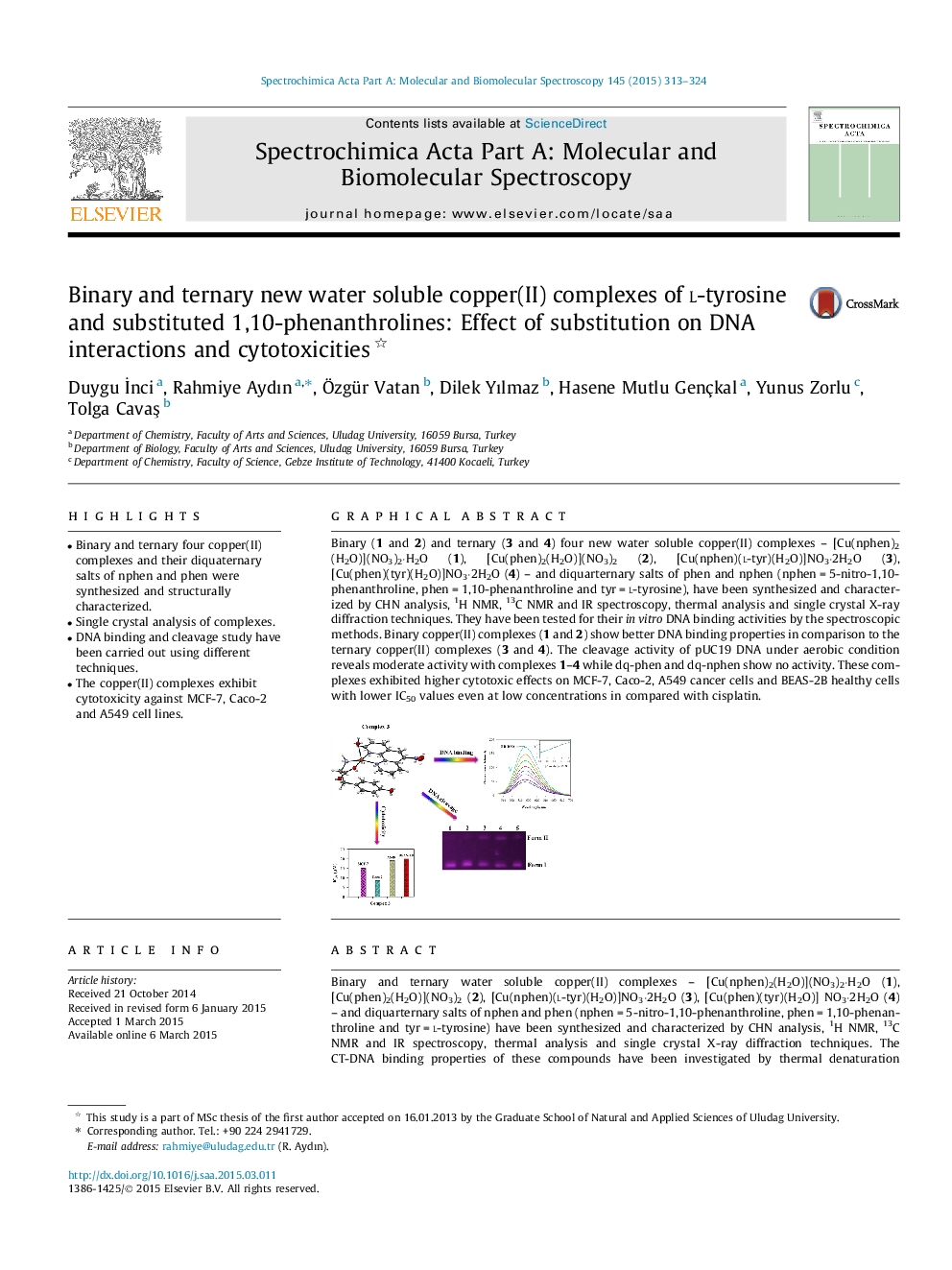| Article ID | Journal | Published Year | Pages | File Type |
|---|---|---|---|---|
| 1228990 | Spectrochimica Acta Part A: Molecular and Biomolecular Spectroscopy | 2015 | 12 Pages |
•Binary and ternary four copper(II) complexes and their diquaternary salts of nphen and phen were synthesized and structurally characterized.•Single crystal analysis of complexes.•DNA binding and cleavage study have been carried out using different techniques.•The copper(II) complexes exhibit cytotoxicity against MCF-7, Caco-2 and A549 cell lines.
Binary and ternary water soluble copper(II) complexes – [Cu(nphen)2(H2O)](NO3)2·H2O (1), [Cu(phen)2(H2O)](NO3)2 (2), [Cu(nphen)(l-tyr)(H2O)]NO3·2H2O (3), [Cu(phen)(tyr)(H2O)] NO3·2H2O (4) – and diquarternary salts of nphen and phen (nphen = 5-nitro-1,10-phenanthroline, phen = 1,10-phenanthroline and tyr = l-tyrosine) have been synthesized and characterized by CHN analysis, 1H NMR, 13C NMR and IR spectroscopy, thermal analysis and single crystal X-ray diffraction techniques. The CT-DNA binding properties of these compounds have been investigated by thermal denaturation measurements, absorption and emission spectroscopy. The supercoiled pUC19 plasmid DNA cleavage activity of these compounds has been explored by agarose gel electrophoresis. The cytotoxicity of these compounds against MCF-7, Caco-2, A549 cancer cells and BEAS-2B healthy cells was also studied by using XTT method. The complexes 1–4 exhibit significant high cytotoxicity with low IC50 values in compared with cisplatin. The effect of the substituents of phen and coordinated amino acid in the above complexes are presented and discussed.
Graphical abstractBinary (1 and 2) and ternary (3 and 4) four new water soluble copper(II) complexes – [Cu(nphen)2 (H2O)](NO3)2·H2O (1), [Cu(phen)2(H2O)](NO3)2 (2), [Cu(nphen)(l-tyr)(H2O)]NO3·2H2O (3), [Cu(phen)(tyr)(H2O)]NO3·2H2O (4) – and diquarternary salts of phen and nphen (nphen = 5-nitro-1,10-phenanthroline, phen = 1,10-phenanthroline and tyr = l-tyrosine), have been synthesized and characterized by CHN analysis, 1H NMR, 13C NMR and IR spectroscopy, thermal analysis and single crystal X-ray diffraction techniques. They have been tested for their in vitro DNA binding activities by the spectroscopic methods. Binary copper(II) complexes (1 and 2) show better DNA binding properties in comparison to the ternary copper(II) complexes (3 and 4). The cleavage activity of pUC19 DNA under aerobic condition reveals moderate activity with complexes 1–4 while dq-phen and dq-nphen show no activity. These complexes exhibited higher cytotoxic effects on MCF-7, Caco-2, A549 cancer cells and BEAS-2B healthy cells with lower IC50 values even at low concentrations in compared with cisplatin.Figure optionsDownload full-size imageDownload as PowerPoint slide
